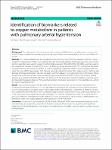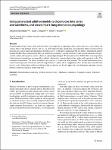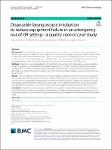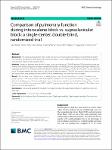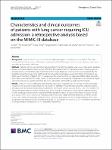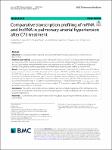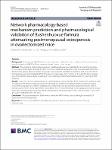Search
Author
- Daqing, Ma (3)
- Alexis, Ferré (2)
- Anna, Lybeck (2)
- Ashish K., Khanna (2)
- next >
Subject
- intensive care unit (8)
- acute respiratory dist... (5)
- chronic obstructive pu... (5)
- ICU (5)
- next >
Has File(s)
Search Results
The pathogenesis of pulmonary arterial hypertension (PAH) and associated biomarkers remain to be studied. Copper metabolism is an emerging metabolic research direction in many diseases, but its role in PAH is still unclear. |
Common physiological time series and waveforms are composed of repeating cardiac and respiratory cycles. Often, the cardiac effect is the primary interest, but for, e.g., fluid responsiveness prediction, the respiratory effect on arterial blood pressure also convey important information. In either case, it is relevant to disentangle the two effects. Generalized additive models (GAMs) allow estimating the effect of predictors as nonlinear, smooth functions. These smooth functions can represent the cardiac and respiratory cycles’ effects on a physiological signal. We demonstrate how GAMs allow a decomposition of physiological signals from mechanically ventilated subjects into separate effects of the cardiac and respiratory cycles. |
Reusable laryngoscopes have been reported to be superior to disposable laryngoscopes with plastic blades during emergent intubations. Surprisingly, at our institution a quality reporting system revealed a high number of equipment failures with reusable laryngoscopes in an emergency out-of-OR (operating room) setting. As recent studies indicated an improved quality of disposable laryngoscopes, we hypothesized that a thoroughly evaluated disposable laryngoscope would result in less equipment failure in an emergency out-of-OR setting. |
Prolonged mechanical ventilation (PMV), mostly defined as mechanical ventilation > 72 h after lung transplantation with or without tracheostomy, is associated with increased mortality. Nevertheless, the predictive factors of PMV after lung transplant remain unclear. The present study aimed to develop a novel scoring system to identify PMV after lung transplantation. |
The speckle tracking ultrasound is an innovative technology enabling distinct assessment of diaphragmatic movement, yet the relative data are scarce. In this pilot study, we sought to evaluate the predictive value of the weaning outcome of automatic speckle tracking in assessing diaphragm excursion. |
The supraclavicular plexus block (SCB) and interscalene plexus block (ISB) have the potential to pulmonary function, the duration of the potential remains uncertain. So, we compared the effect of SCB and ISB on pulmonary function, especially the duration time. |
Lung cancer (LC) is the most common solid tumor type in the intensive care unit (ICU). This study investigated the characteristics of LC patients admitted to the ICU, the major reasons for their admission, short-term mortality, and associated risk factors. |
To investigate mRNA and long non-coding RNA (lncRNA) expression profiles in monocrotaline (MCT)- mice. |
Respiratory infections are the most common reason for admission to paediatric intensive care units (PICU). Most patients with lower respiratory tract infection (LRTI) receive broad-spectrum antimicrobials, despite low rates of bacterial culture confirmation. Here, we evaluated a molecular diagnostic test for LRTI to inform the better use of antimicrobials. |
Postmenopausal osteoporosis (PMOP) is a common bone disorder characterized by low bone mineral density and microstructure deterioration [1]. It is estimated that more than 15% of postmenopausal women over 50 years old are suffering in PMOP worldwide [2]. Most of them have low back pain, hunchback and fragility fractures in different degrees [3]. Although there exist a large amount of anti-osteoporosis drugs such as active vitamin D, estrogen receptor modulators, bisphosphonates and parathyroid hormone [4], various undesirable effects limit their application and efficacy [5]. Natural products and herbs attract increasing attention for their potential anti-osteoporosis effects and relative safety |

